I issued an episode of my podcast “Travel tales from beyond the Brochure” where I spoke about “Get Outside Day”, and explored the topic of the impact of getting outside on mental health a little further here. We all know that being active is good for our physical health but can hiking actually help depression? Is running good for anxiety? What is forest bathing, anyway?
Can Walking help your mental health?
For me, walking outside is very much the number one way I undertake self-care and mentally recharge myself. The combination of being outside and physically doing something I find enjoyable is an ideal way to improve my mental health. Indeed, while I know that walking for like 7-8 miles is going to do wonders physically, especially when compared to sitting on my chair all day at my computer, it’s the mental side that benefits me more I think.

Walking through the woodland in Portland Park, Kirkby-in-Ashfield, near where I used to live.
I’m one of those people who get, what you might call, ‘cabin fever‘. I don’t like being in the same place for too long. It’s evident even when I travel, and I move to a new city every three or four days because otherwise I get bored and slightly stressed and angsty. The same applies to my living conditions – while I might be surrounded by the same walls for months and even years on end, if I don’t get out of them every so often (and I pretty much mean daily), it starts to grate on me. And while in principle it’s better if I can get out somewhere a bit open and wild, even just a walk around the block definitely helps my mind.
It does many things. It allows me to clear my head. It helps me focus. It even serves to wake me up, if I’m feeling a bit lethargic. For instance, I always used to walk to work, and when I moved to Nottinghamshire, I drew a circle of about 4 miles around my office and said ‘I will not live outside that circle’, because I wanted to be able to walk to and from work most days.
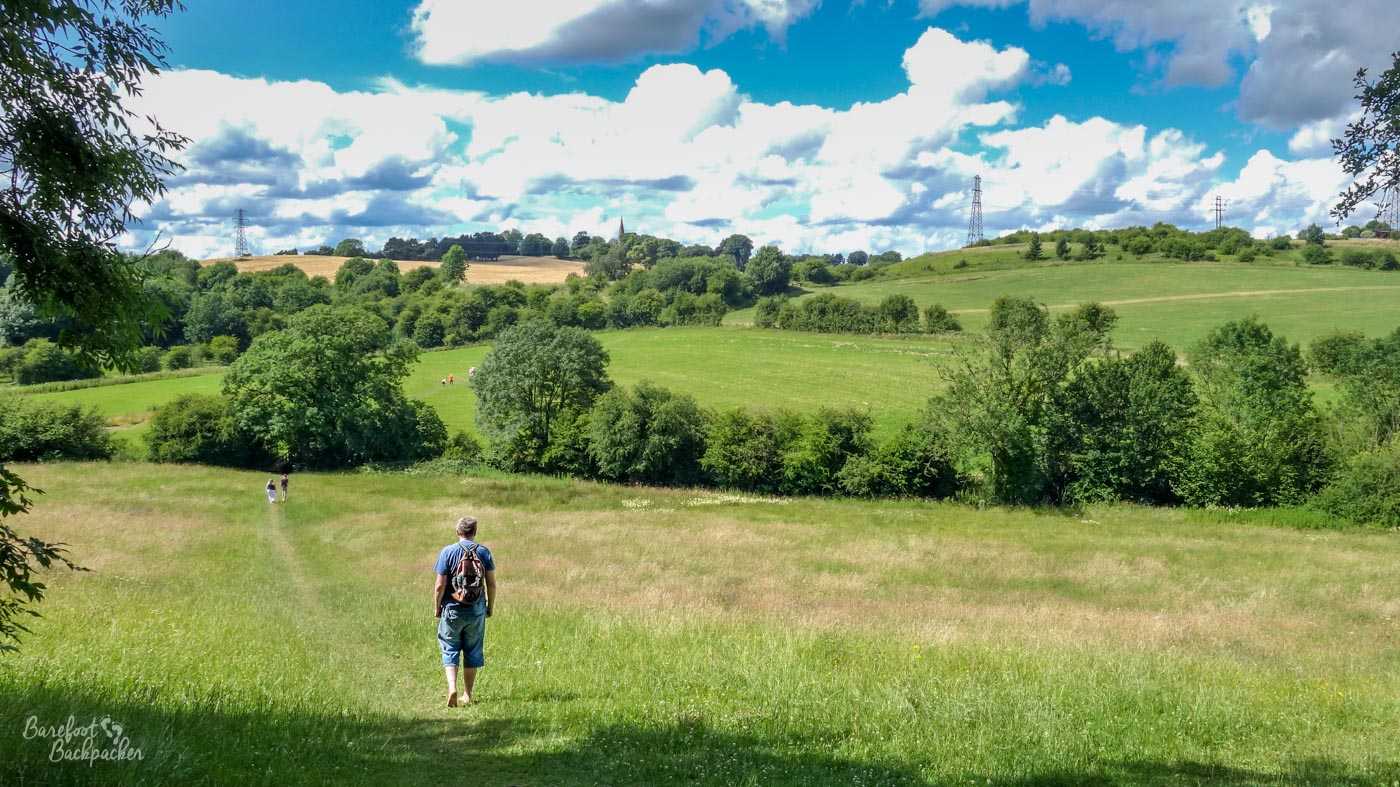
Part of the path I used to walk on the way to/.from work; this is Bentinck Banks, Kirkby-in-Ashfield, and it used to be a railway yard.
As it happens, where I ended up living was a 2½ mile walk, in daylight anyway. That route took me through two small woodlands and over the fields of the nearby country park that used to be a railway yard serving the local coal mine. I say ‘daylight’ because it was largely over grass with a couple of steep inclines and no lighting; you can guess how someone of my … shall we say, abilities, would fare with walking there in darkness. In Winter I tended to take the road through the town centre – it was about a mile and a half longer, much less interesting, but at least I could see where I was going.
And I guess that’s an example of showing that even people who live in suburbia, who drive to work, can often find a small piece of outdoors that serves their needs, even if it’s just a few minutes a day in a lunch break.
Does running help anxiety? Is running good for mental health?
I’ve always liked running; I guess I see it as ‘providing the same benefits as walking, but for when I’m impatient’. I’m not one of those fitness addicts who goes out running at 5am, well, I mean I often go running at 5am in Summer but that’s just because no-one else is out and about so I feel much more free and less stressed about people getting in my way. I’m also slightly self-conscious about my running, so I find it better for my mental health to do it on the roads when there’s fewer people about – obviously in a large group like Parkrun where everyone’s doing the same thing at the same time, that’s not an issue at all.
What I mean is, I don’t focus on running for physical health, and I’m not someone who’s always trying to better their times etc. Rather, I run because I find it, well, fun, in and of itself, as well as knowing that it’s good for my health.
I discovered I liked running while I was at school, somewhat accidentally, I kind of fell into cross-country running because it wasn’t rugby; at the time the ‘cross-country extras’ group was full of people weren’t sporty, but I figured the faster I ran, the sooner I could get home on a Wednesday afternoon, so I … improved by stealth. When I made it to the school team, I tended to finish in the middle of the field when we raced against other schools, but I ran for the enjoyment rather than the finishing position.

Me, at the end of the Northern Schools Cross Country Championships, at Lyme Park, Disley, in March 1993.
Plus I never really baulked a lot at the idea of getting up at sparrow’s fart in the middle of January to run around a country park for 10km in the snow [you warm up after about 200m, don’t worry!]; I just always felt ‘attuned’ to it. So while these days I might whinge to the marshals at Parkrun every Saturday, I do at least do so with my tongue firmly in cheek.
I do find running to be great for my mental health, but largely it must be said for semi-physical reasons. I feel all my run-time (ho ho) is filled with thoughts of ‘omg this hill is going to kill me’ and ‘why am I doing this, why, why’, and thus I don’t have the time or space to think about what’s been stressing me. This was especially pertinent in Sheffield – there was a four mile loop around where I used to live, of which half a mile (pretty much at the halfway point) was flat. The rest … was not.
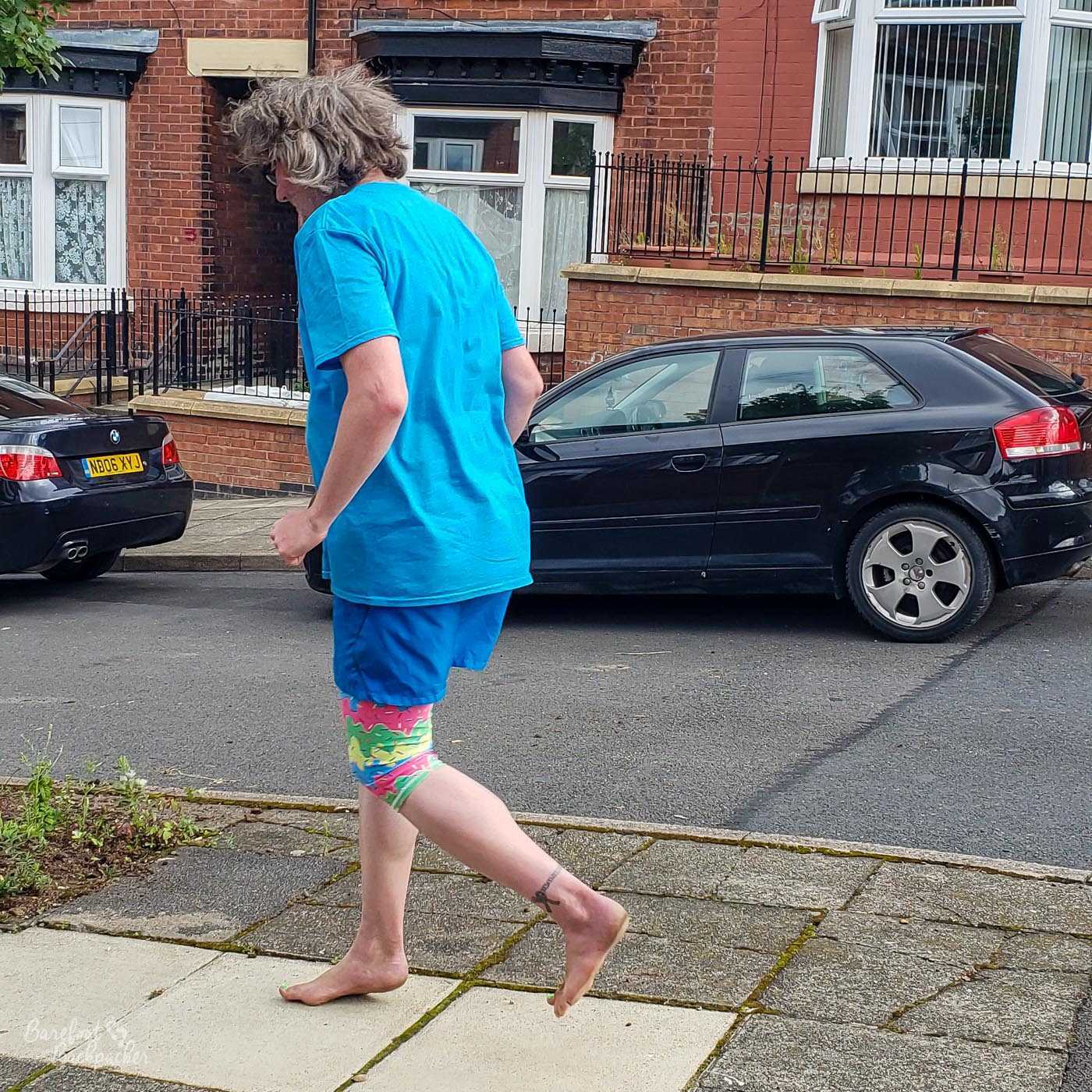
Me, running through the suburbs of Sheffield.
Then, when I finish the run, I’m too physically exhausted to think about my angst. That said, also, the state of mind of ‘having finished’ a run is one of euphoria, the sense of achievement of having done something that … hard. The best part of a long run is looking back and going ‘wow, I did that’, and it’s something that can never be taken away from you. I’ll concede I’ve never run a marathon – indeed while not the longest I’ve ever run for, the longest official race I’ve ever done was a half marathon back in … 1992, in Southport, a town also not noted for its hills, so as half marathons go, it wasn’t exactly taxing. But, still, I did it.
But, I’ve mentioned Parkrun a couple of times, and I’ll do a post specifically about this one day, but in terms of mental health, Parkrun is the ideal way for me to go running. It’s the same vibe as the early morning school team competitions (Saturday morning, 9pm ish, in a cold park) but without any pressure to do well. It’s running purely for the pleasure of it. Obviously there are always people who actively use it as running training and/or try to break a PB each time, but most people who do it are just there because it’s a way to get out on a Saturday morning. They jog with people they know, with their children, or even with a dog. You don’t even need to run – a lot of people simply walk around the course to chat with friends. At the time of writing, my usual Parkrun is at Queen’s Park, Glasgow.
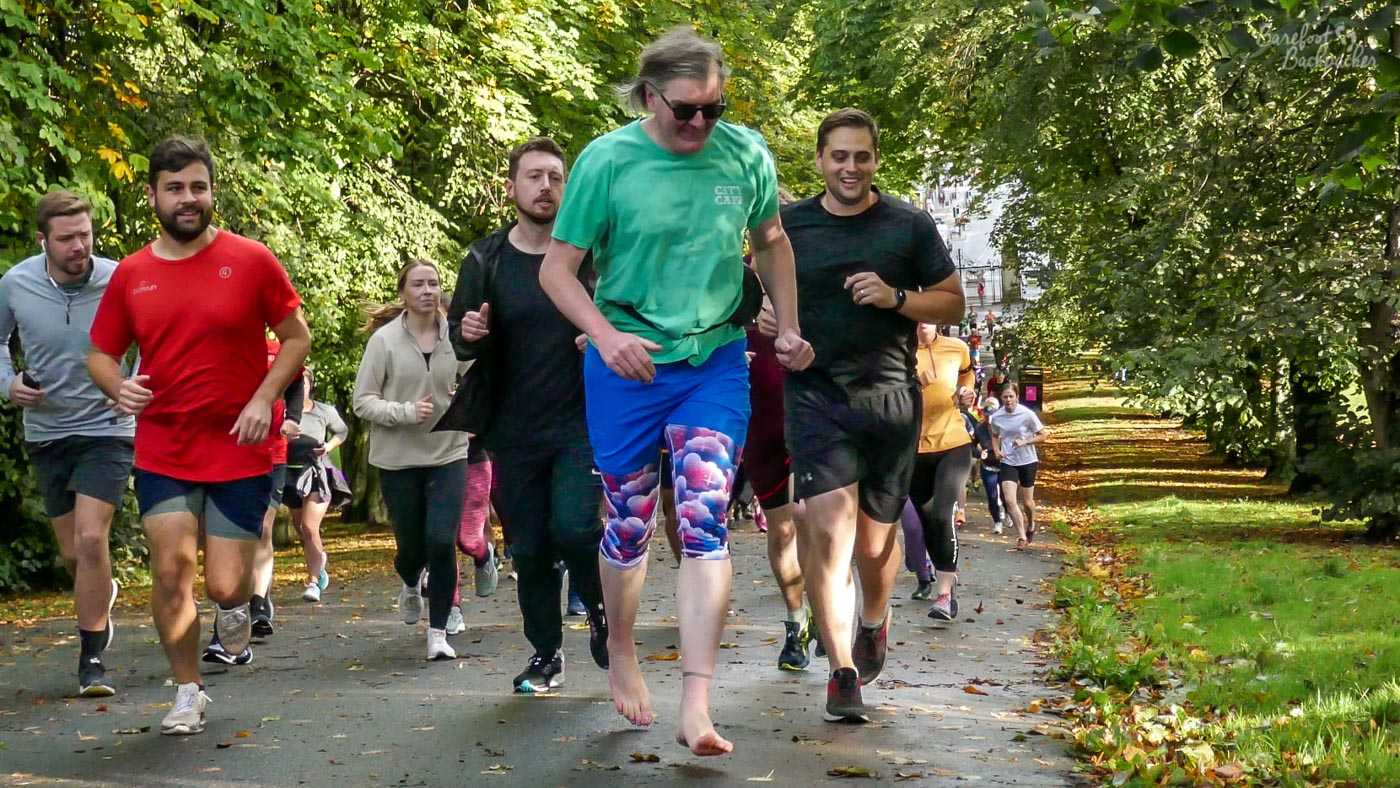
Me, a couple of hundred meters after the start of the Parkrun at Queen’s Park, Glasgow. Picture taken by one of the Parkrun volunteers.
I run, well, jog, and I’ll always try to push myself, but I’m not even really trying to beat my best times. I mean, it’s always nice to clock a fast time and there’s a finish time I’d feel disappointed if I were slower than, but in general the fun for me is to just have got out and done it. Normally as I say I’m a solo runner, like I’m a solo hiker, because I’m someone whose nature is quite solitary, but with running specifically, I’ve always found that having other people around, doing the same run as me, helps me on a bit – I have someone to ‘aim for’ as it were, as well as other people to concentrate on rather than the road, and I think that helps distance go past quicker.
What is ‘Forest Bathing’?
There’s a recent trend, a concept apparently imported from Japan, called ‘forest bathing’. The idea is, simply, to immerse yourself in the woodland and let your senses be flooded by the forest atmosphere. It’s believed to recharge you, improve your wellbeing, and kickstart your nervous system, reducing any stresses and ‘fight or flight’ stimuli you might be feeling. It’s also believed to be beneficial to improve the immune system.
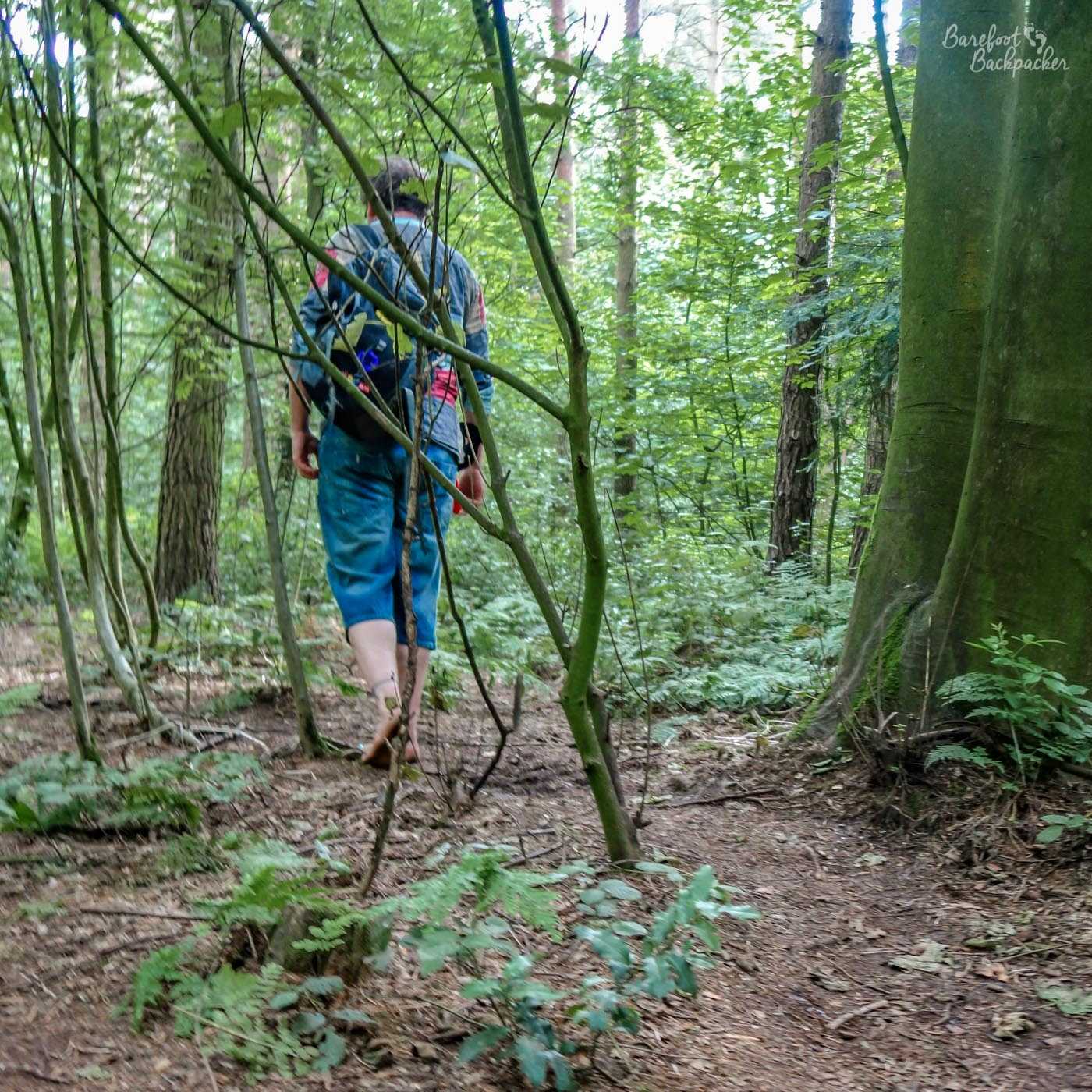
Channelling my ‘wood-elf- vibes. Image is taken in the woodland near where I used to work.
The Ordnance Survey website gives this, maybe scientific, explanation. I’m not a scientist, let alone a neurologist, so I’m just going to say what they say. And I quote. “The sympathetic nervous system is also known as fight or flight. It helps direct the attention and energy from our body into keeping us safe when we come up against a stress factor. This is where we should only be spending short bursts of time. The parasympathetic nervous system is our rest and digest mode – this is where we should be spending most of our time. Whilst any time outside will help boost your mental and physical health – nature therapy is a gentle practice designed to help support your wellbeing in a natural environment – be it a woodland, beach, park or even your own back garden.
Also known as forest bathing – it’s the practice of immersing yourself in nature to open up your senses to the world around you and to kick start your parasympathetic nervous system. In essence, it improves your well-being.”
Thing is, I’ve always had a particular passion for woodland; I’ve described myself as a wood-elf before now, and pretty much always have done, pretty much ever since I was aware of the existence of wood-elves (in a fantasy environment, of course!). I think it stems largely from when I was a teenager. My uncle would take the dog for a walk around the nature reserve at Formby, about 3 miles from where we lived; he used to drive there then drop me off at the entrance, and I’d take any of several different routes and run home. The nature reserve was full of pine trees and sand/bark covered trails. I’d be the only person there for much of it, just me and the trees, and the red squirrels which I very rarely saw, and it was very pleasant, very relaxing, I could just cast away the worries of my school life, and think only of my breathing, of my footsteps, of the air, a mix of pine and salt, of the quiet. It felt, safe I guess. It felt like it was my territory, my home.

The nature reserve at Formby; these were the sort of paths I used to run along in my teenage years. Not barefoot, incidentally; that was a later facet.
I was also drawn to their slightly ‘hidden’ vibes. That is to say, when you’re walking through a forest, even when on a clearly-marked trail, the path is rarely straight; it’ll bend around the trees and it won’t always be clear where you’re going. Get off the trail and it’s easy to get lost amongst the trunks. I always loved the idea of being so close to everyone else in the world, and yet just out of sight, out of earshot, hidden away. Hindsight might suggest this is a metaphor for my own questions of identity, but teenage me was not aware of these things.
Even today I’m very much focussed on the forest. For example, I used to work on an out-of-town business park, and on the other side of our building’s car park was a small woodland. So sometimes, if I was feeling tired or stressed, I’d leave my desk for 10 to 15 minutes and just walk a little through the trees. Despite its location, there were rarely other people there and you could barely hear the traffic from the main road, so it was nice and restful, peaceful even. In addition, whenever I’m travelling, I do try to make a point to take on at least one day a wander through a local woodland or forest – the one I ended up in on the edge of Cluj-Napoca in Romania had a reputation for ghosts and UFOs and it felt a perfect place to just stand and let the atmosphere take over me. It was quite a dense woodland with few paths and, on my trip, deep leaf fall cover, so it was easy to see how such tales would have arisen.
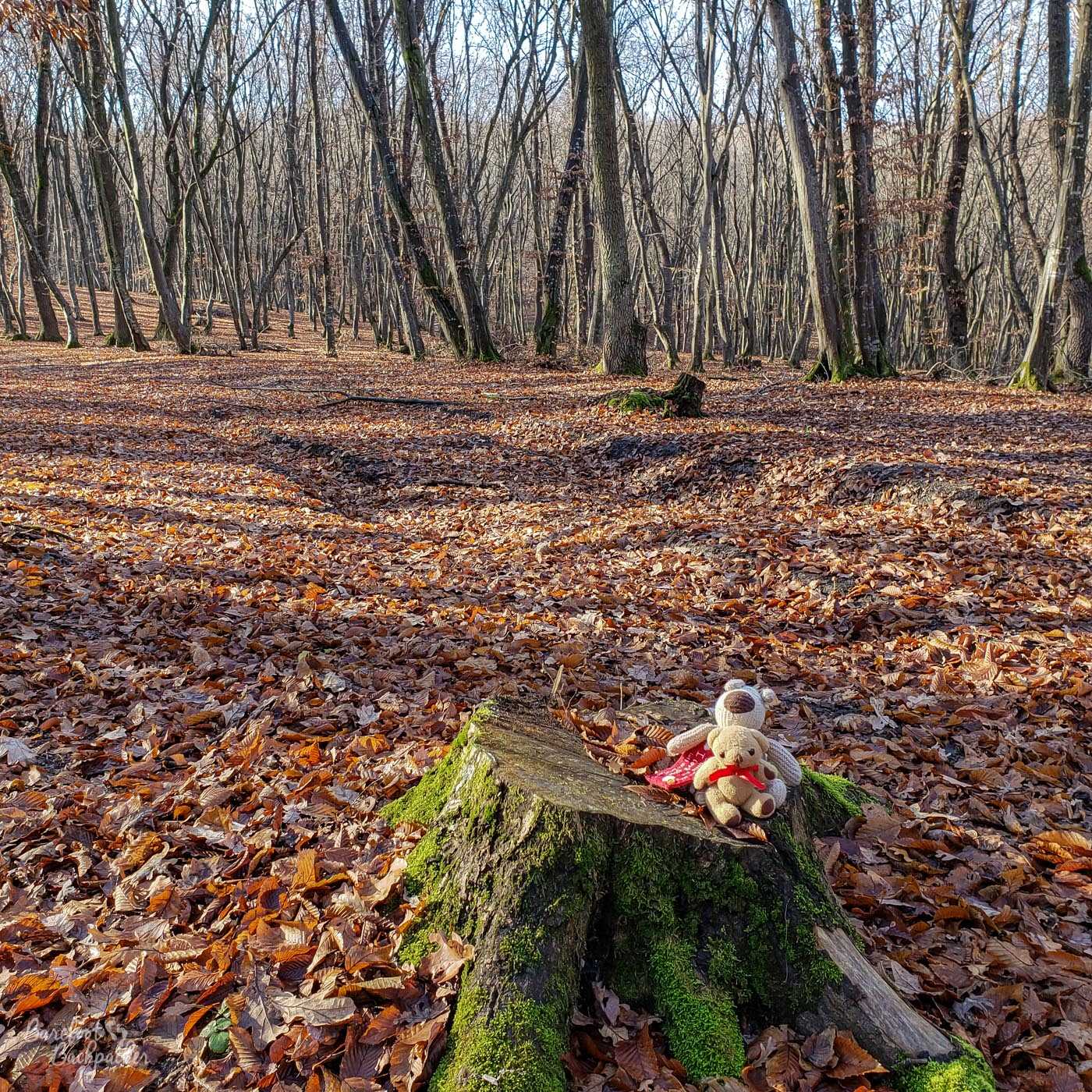
The forest just outside Cluj-Napoca. I don’t know if Baby Ian & Dave are protecting me from aliens and ghosts, or pretending to be aliens or ghosts.
Anyway, I guess what I’m saying is, I was feeling the benefits of woodlands long before it became trendy.
It doesn’t have to be woodlands of course, and certainly when I’m hiking or walking there’s a whole plethora of environments I feel relaxed and comfortable in, including clifftop footpaths and wide open spaces in the foothills. It’s just, for me, it’s always been woodlands I’m more drawn to, and where I feel the most relaxed and chilled, if I allow myself to let go (which is always the bigger problem, but being in that environment certainly makes letting go a lot easier). Well, not *the* most relaxed, but that’s … a tale for elsewhere … !
What is ‘Earthing’ / ‘Grounding’? Are there mental health benefits to ‘Earthing’?
The other modern theory that has been popular online, and related to forest bathing in a way, is that of ‘earthing’, also known by some as ‘grounding’. Again, I’m no scientist so I don’t know if this is a valid concept, or if it’s just some ‘hippie woo’, but in holistic terms, the principle certainly has beneficial effects for me.
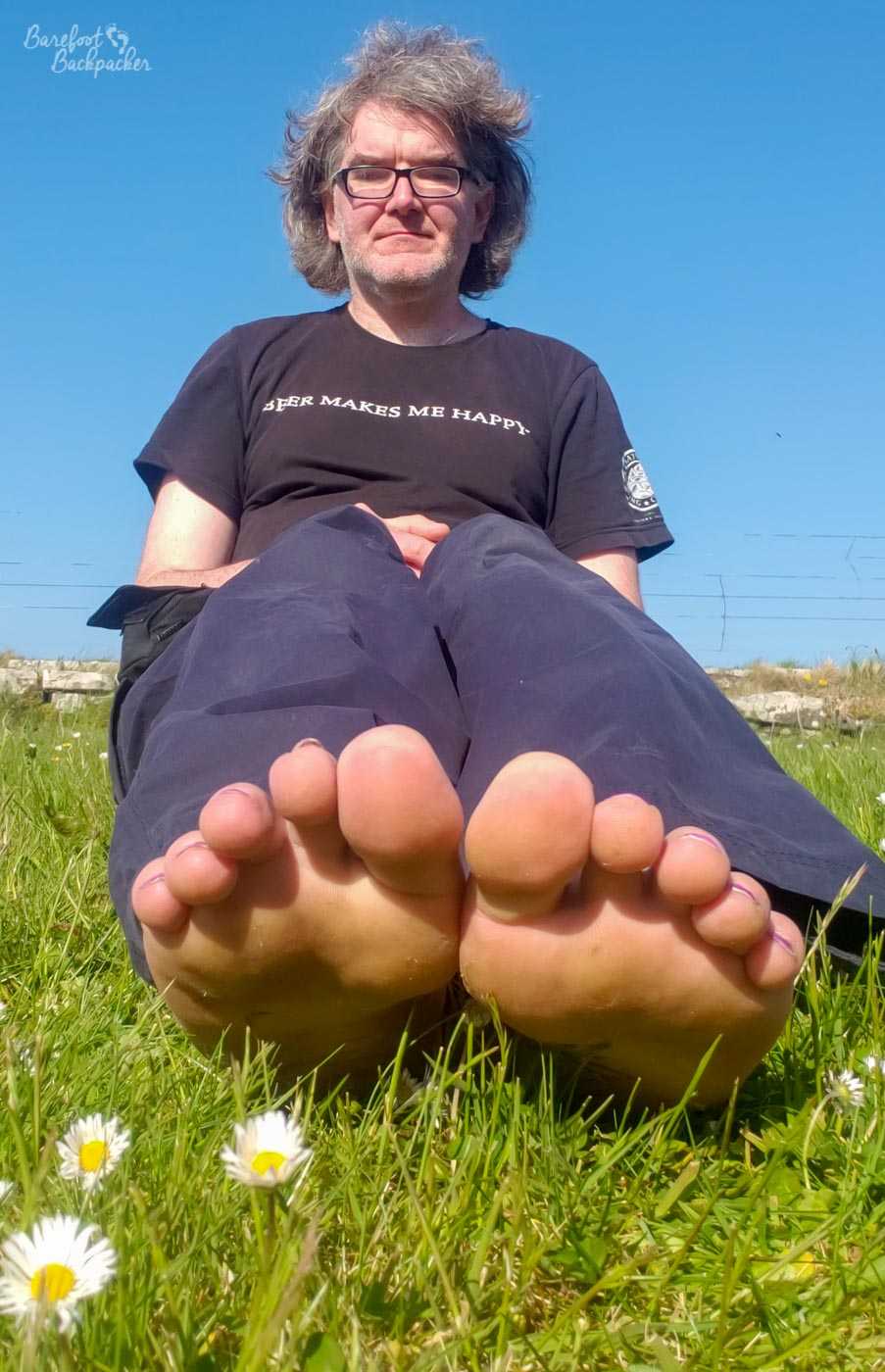
Gratuitous picture of my toes. What do you expect?!
Earthing is a very simple concept. In basic terms, it’s the idea that connecting ourself with the earth directly is beneficial for our health, both mental and physical, and is said to educe inflammation, and chronic pain, and improve the cardiovascular system and even your mood. The alleged science behind this is to do with electrical conductivity. In essence, being ‘grounded’ allows electrons to pass between your body and the ground, restoring the body’s natural defence systems. This can only happen of course with direct contact – skin to soil, as it were, with nothing in between.
You can see where I’m going with this, obviously.
While it’s perfectly possible to ‘earth’ yourself through any body contact, lie sitting on the grass with your hands on the ground for half an hour, most people who advocate earthing tend to promote doing so by being barefoot. The logical reason for this is it’s the easiest and most efficient way to ground yourself, as you can do it without any extra and convoluted effort on your part. Rather than going for a walk and having to run you hand along every single hedge and bush you find, and going out of your way to touch the ground at every opportunity, being barefoot means you’re constantly ‘grounded’ and therefore getting the full and maximal benefits you can.
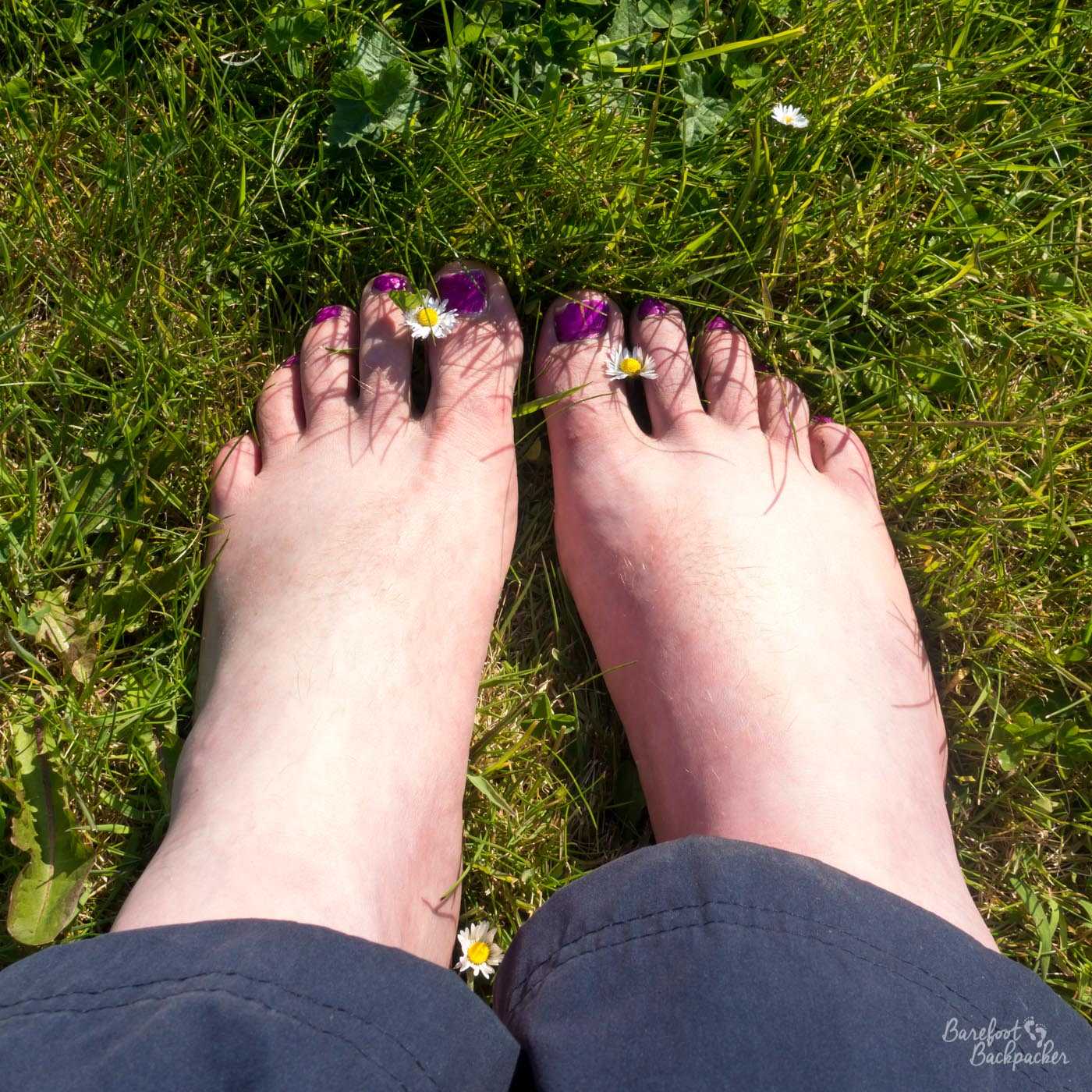
Grounding on Papa Westray, Orkney. Daisies optional, but you know the way I roll.
Do I have to be Barefoot when Grounding?
Studies have shown, albeit in small groups, that going barefoot does indeed seem to educe pain and improve mood, although in addition both of these two factors are hard to measure accurately And the exact mechanism for this apparent improvement is et to be scientifically confirmed
But, of course, I don’t walk barefoot because I believe that makes it easier for elections to travel from the ground into my body. Rather, I walk barefoot in pat because, regardless of the exact mechanism why, it definitely does improve m mood. When I Get Outside, I’ll often be barefoot because the combination of both makes me less stressed, more calm, happier, in a way. Interestingly, it’s not just me that’s noticed this. When I was on The Hike Across Great Britain in the summer of 2019, my hiking partner Becky directly stated that I appeared to be happier, bouncier, more amenable to chatting etc, when I was able to hike barefoot, and even when I was in the minimalist sandals that I had for the journey, I was much less content and a little more irritable. The early days on the Pennine Way, after the ripped toenail incident, when I was stuck in walking shoes, when the rain was relentless, and the views misty, were a bit of a low point on that hike, and I’m sure I’d have felt a bit better if I could have waded through the damp patches barefoot.
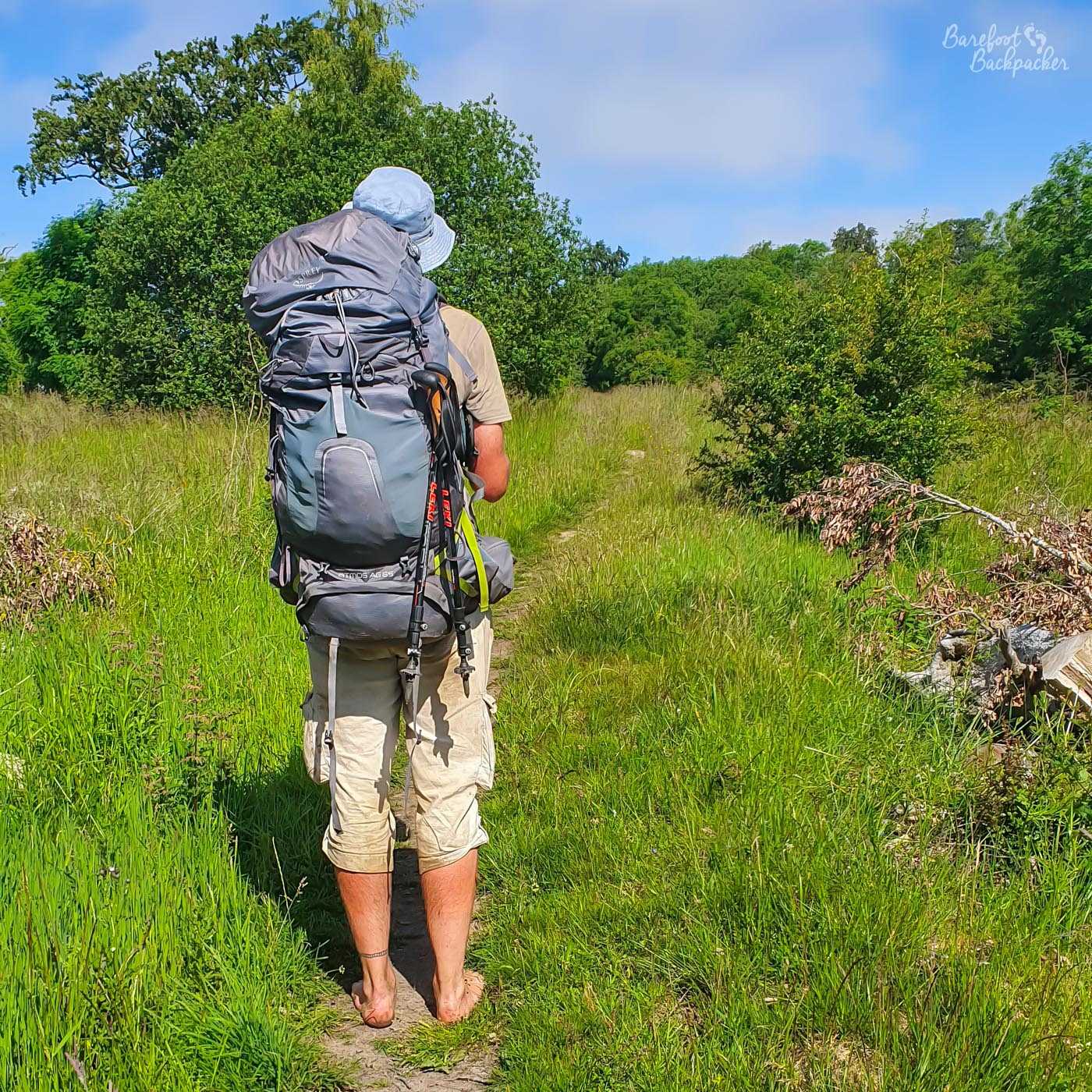
Hiking barefoot in Scotland while on The Hike. Picture taken by Becky The Traveller.
As to why, I talked a bit about this both in my very first podcast episode all about Barefoot Travel, and in my post about why I am the Barefoot Backpacker”, but in essence I feel too restricted in shoes, even sandals most of the time to be honest, and being barefoot means I feel free, and therefore more comfortable. My feet get too warm if they’re enclosed and that affects my mood negatively, in the same way as if you’re wearing a sweatshirt on a hot summer day. Plus I feel lighter, I feel more attentive to my surroundings (although my experiences with my dyspraxia might suggest otherwise), and I feel more like the person I feel I am, rather than masking or hiding myself behind a fake … face, I guess. And I mask my real identity a lot more than you might imagine; I mean I pretended to be a heterosexual man for a couple of decades lol.
If you abide by the principles of ‘earthing’, there are certain surfaces that don’t ‘work’, as it were. These are mainly man-made surfaces like asphalt and concrete, so my barefoot parkruns generally wouldn’t count. But for me, that’s still Getting Outside, that’s still freeing my feet, that’s still making me chilled, and I still feel the mental health benefits from it. But certainly when I Get Outside on hikes for instance, I’m doing it over grass, over natural ground, through woodland, on ciffside walks, in the hills, in wide open spaces, and they’re all surfaces that ‘earthing’ promoters advocate for. And while I definitely feel happier in the countryside than the local park, that’s less to do with the surface I’m standing on and more to do with simply being somewhere out in the vastness of nature, where I can breathe in the fresh air and stand and look out at the landscape, where I’m more likely to be on my own, and can feel content in myself, without external stress.

Grounding on Lose Hill, in the Peak District. I’m not quite sure what the stones represent, or even if they’re an old feature or a brand new one, but matches the barefoot hippy vibe pretty well I think.
One of the last hikes I did near Sheffield before I moved up to Glasgow was to finally visit Mam Tor, and while the top of that hill was quite busy, the path heading eastwards towards Lose Hill was both comfortable under bare feet and somewhat devoid of people – I almost saw more cows on the trail to be honest. It was a late afternoon to mid evening, the skies were clear, and the views vast, and it just felt like a really lovely place to be.
Does getting outside always help with mental health?
Sometimes, my mental health is poor enough that none of this really works for me. It’s not 100% foolproof, of course. There have been many occasions where I’ve dragged myself out of the house in a funk, and shuffled along listlessly as I walk through the local area, forcing every stride rather than enjoying it. Where my mind is so overburdened with angst and mood that it’s all I can think about with each footstep. And in those states, I tend to walk slowly, much slower than normal, as if nothing really matters and I don’t feel like I have any need to do anything more than trudge because either it won’t change anything or I’m actively avoiding it. And when I arrive back home, I’m feeling no better than when I left. But, of course, I’m feeling no worse either, and the chances are, even if I didn’t enjoy it, the act of going out stopped me from slipping even deeper into my mood.

Stanage Edge, in the Peak District. My happy place.
In any case, and regardless of any scientific benefit to the nervous system, for me at least, being outside, being in woodlands, helps my mental state of mind more often than not. It’s hard to prove this specifically, but I just know that after spending time outdoors, I generally feel more awake, happier, and calmer than I did before I started.